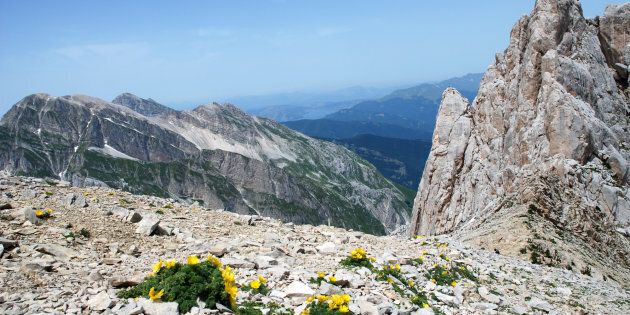
When we moved from being four-legged creatures to standing on two feet, a psychological shift is presumed to have taken place. Blumenberg argues that by standing upright we developed the ability to anticipate the future and writes that "increasing the horizon developed intelligence" (Blumenberg 2006:519).
Seeing a greater distance ahead we were able to speculate, calculate and foresee the movement of an animal ahead of us, or to anticipate danger from a greater distance. We gained the ability to be forward thinking.
Do we still use our foresight? How much do we use it in relation to climate change, for example?
Italy is a mine of information regarding the history of mankind and Italian mountains are even more so. Many mountains in Italy have been spared heavy development and have excellent archaeological sites that offer insight into pre-historic peoples.
The region of Abruzzo, Central Italy, is famed for its mountains, including the highest summit outside of the Alps, the Gran Sasso at 2,912 meters. The Fucino area "contains the oldest attestations of human presence from the Upper Palaeolithic" states Agostini et al. (2008:103). A series of 15 Upper Palaeolithic sites, mostly caves at altitudes of between 700 meters and 1000 meters, have been studied and reveal a wealth of fascinating discoveries.
One cave called Grotta Continenza was inhabited almost continuously between 13,500 and 5000 BC. In this site the evidence studied comes in the form of heaps of domestic waste, tools, hearths, pebble pavement, decorated objects, painted stones and graves. Boschian et al. (2017) claim there is evidence of rapid cultural turnover as people adapted or simply coped with dramatic climate change. Overall the study concludes that cultural changes accelerated through time, moving from slow evolution to fast modification, supporting that hypothesis that "adverse conditions foster adaptation more than favourable ones" (Boschian et al. 2017:23).
The conditions these mountain dwellers coped with were broadly the same throughout Europe in the Upper Palaeolithic period. First, there was a period of extreme cold with expansion of ice and snow, and thereafter there was large temperature oscillation, and finally a more temperate climate.
Due to their steep gradients, mountains present a great variety of climates and corresponding flora and fauna within a relatively short distance. Still today the level of biodiversity and richness of resources that mountains offer is outstanding compared to lowlands. Apparently between approximately 13,000 and 12,000 B.C. Agostini et al. (2008) write that three of the caves had distinctive groups of people inhabiting them. Within a radius of 10 km they accessed a variety of different habitats with diverse foods.
Over a period of millennia with extreme weather changes, people altered their diet, their foraging and hunting techniques and they accessed higher or lower altitudes depending on climatic conditions.
Do any of us possess the skills and the foresight to be so adaptable within the context of our society and the climatic challenges we face?
I asked Professor Silvano Agostini, one of the authors of the research cited above, and government Director of Archaeology for Abruzzo, if he could imagine what Palaeolithic peoples' perception might have been like he said:
"Personally, I think that their artistic, ideological and cultural sphere is more complex than we can imagine, with articulate and dialectical cycles and everyday phenomenology... rather like today. Instead of being focused on trying to understand nature, they were probably concerned with discussing views for solving problems and for understanding daily life, with its issues – like us today."
An archaeological perspective on climate change is instructive, and Professor Silvano Agostini commented on our society saying:
"By losing our vital relationship, our respect and "fear" toward nature, we have reached a catastrophic limit of no return, in other words, the climate change we have caused. Nature will know how to renew itself 4 billion years hence ... but we probably do not know how."
If we choose to we have the capacity to use the foresight that made us what we are today.
Agostini, S., Iacopini, A., Masserotti, M., Barsocchi, S., Porsia, C. (2008) "Applicazione delle tecnologie GIS per la ricostruzione della presenza umana nella Preistoria del Fucino (Abruzzo)" in Preistoria Alpina, 43 (2008): 101-115 ISSN 0393-0157 © Museo Tridentino di Scienze Naturali, Trento 2008
Boschian, G., Serradimigni, M., Colombo, M., Ghislandi, S., Grifoni Cermonesi, R. (2017) "Change fast or change slow? Late Glacial and Early Holocene cultures in a changing environment at Grotta Continenza, Central Italy" in Quaternary International, xxx, 1-23.
Pavesich, V. (2015) "Hans Blumenberg; Philosophical Anthropology and the Ethics of Consolation", Naturalism and Philosophical Anthropology; Nature, Life and the Human between Transcendental and Empirical Perspectives, (ed) Honenberger, P. Basingstoke: Palgrave Macmillan.